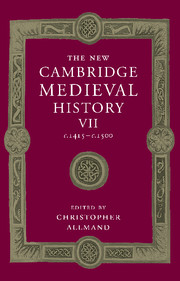Book contents
- Frontmatter
- PART I GOVERNMENT
- PART II ECONOMIC AND SOCIAL DEVELOPMENTS
- PART III SPIRITUAL, CULTURAL AND ARTISTIC LIFE
- PART IV THE DEVELOPMENT OF EUROPEAN STATES
- 17 Germany and the Empire
- 18 Hus, the Hussites and Bohemia
- 19 France
- 20 Burgundy
- 21 England
- 22 The Celtic world
- 23 Italy
- 24 The Iberian peninsula
- (a) Aragon
- (b) Castile and Navarre
- (c) Portugal
- 25 The Swiss Confederation
- 26 The States of Scandinavia, c. 1390– c. 1536
- 27 Hungary: Crown and Estates
- 28 The Kingdom of Poland and the Grand Duchy of Lithuania, 1370–1506
- 29 Russia
- 30 Byzantium: The Roman Orthodox World, 1393–1492
- 31 The Latin East
- 32 The Ottoman World
- 33 Conclusion
- Appendix Genealogical Tables
- Primary Sources and Secondary Works Arranged by Chapter
- Index
- Frontispiece
- Plate section
- Map 1 European towns in the late Middle Ages
- Map 2 European commerce and trade
- Map 4 Winds and currents facilitating the discoveries
- Map 5 The universities o f Europe in 1400 and 1500
- Map 6 Germany and the Empire
- Map 20 The Roman Orthodox and Ottoman worlds in the fifteenth century
- References
(b) - Castile and Navarre
from 24 - The Iberian peninsula
Published online by Cambridge University Press: 28 March 2008
- Frontmatter
- PART I GOVERNMENT
- PART II ECONOMIC AND SOCIAL DEVELOPMENTS
- PART III SPIRITUAL, CULTURAL AND ARTISTIC LIFE
- PART IV THE DEVELOPMENT OF EUROPEAN STATES
- 17 Germany and the Empire
- 18 Hus, the Hussites and Bohemia
- 19 France
- 20 Burgundy
- 21 England
- 22 The Celtic world
- 23 Italy
- 24 The Iberian peninsula
- (a) Aragon
- (b) Castile and Navarre
- (c) Portugal
- 25 The Swiss Confederation
- 26 The States of Scandinavia, c. 1390– c. 1536
- 27 Hungary: Crown and Estates
- 28 The Kingdom of Poland and the Grand Duchy of Lithuania, 1370–1506
- 29 Russia
- 30 Byzantium: The Roman Orthodox World, 1393–1492
- 31 The Latin East
- 32 The Ottoman World
- 33 Conclusion
- Appendix Genealogical Tables
- Primary Sources and Secondary Works Arranged by Chapter
- Index
- Frontispiece
- Plate section
- Map 1 European towns in the late Middle Ages
- Map 2 European commerce and trade
- Map 4 Winds and currents facilitating the discoveries
- Map 5 The universities o f Europe in 1400 and 1500
- Map 6 Germany and the Empire
- Map 20 The Roman Orthodox and Ottoman worlds in the fifteenth century
- References
Summary
both at the time and subsequently, the history of fifteenth-century Castile seemed to be one of cosmic chaos, a period of almost constant anarchy until Isabel ‘the Catholic’ and her husband, Ferdinand of Aragon, restored law and order in the 1480s. Observers reacted to the violence and disorder with expressions of weary incomprehension or with reflections on men’s innate greed and disloyalty. On 11 August 1465, for example, the urban chronicler, Garci Sánchez, noted in disbelief that when two men of the Saavedra lineage in Seville quarrelled with others of the Ponce de León faction, several thousands took to the streets, the Saavedra house was sacked and Fernando Arias de Saavedra himself escaped only by fleeing across the rooftops of his district. Nobody but the Devil, he observed three years later, was capable of understanding such feuds between factions (bandos). According to the chronicler Fernán Pérez de Guzmán, matters were not much better at the royal court. Politics there, he reflected, were characterised by endless imprisonments, expulsions and confiscations of wealth ‘for the praiseworthy custom of the Castilians has reached such a point that men will consent to the imprisonment and death of a friend or relative in order to have a share in the booty’. Foreigners, likewise, painted a dismal picture. In 1466 the Bohemian noble Leo of Rozmital travelled widely through the kingdom, and two of his companions described their experiences. The Basque country was ‘wretched’, its people ‘murderous’, the inns ‘evil beyond measure’ and the priests were married and unlearned. Further south they had to cross tracts of wilderness and mountainous territory, and when they visited one of the two rival royal courts, that of Enrique IV, they observed that the king ‘eats and drinks and is clothed and worships in the heathen manner and is an enemy of Christians’. But then Enrique has always been the leading contender for the title of Spain’s worst king.
Keywords
- Type
- Chapter
- Information
- The New Cambridge Medieval History , pp. 606 - 626Publisher: Cambridge University PressPrint publication year: 1998

